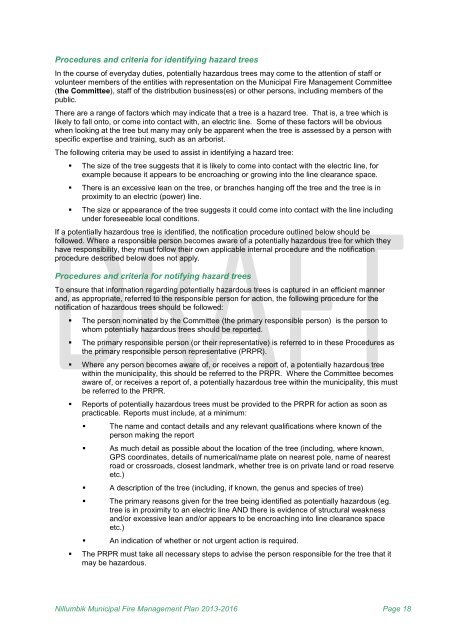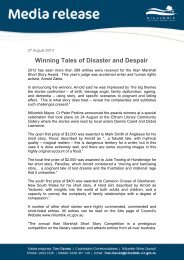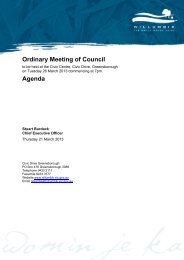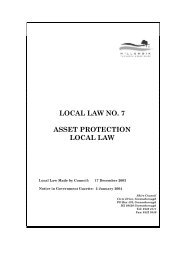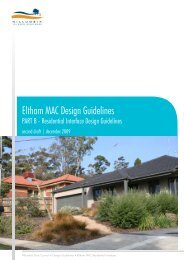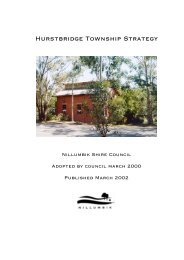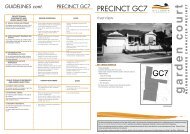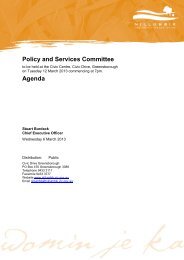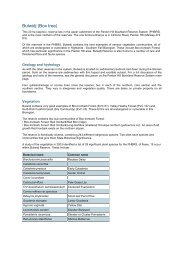Municipal Fire Management Plan 2013â2016 - Nillumbik Shire ...
Municipal Fire Management Plan 2013â2016 - Nillumbik Shire ...
Municipal Fire Management Plan 2013â2016 - Nillumbik Shire ...
Create successful ePaper yourself
Turn your PDF publications into a flip-book with our unique Google optimized e-Paper software.
Procedures and criteria for identifying hazard treesIn the course of everyday duties, potentially hazardous trees may come to the attention of staff orvolunteer members of the entities with representation on the <strong>Municipal</strong> <strong>Fire</strong> <strong>Management</strong> Committee(the Committee), staff of the distribution business(es) or other persons, including members of thepublic.There are a range of factors which may indicate that a tree is a hazard tree. That is, a tree which islikely to fall onto, or come into contact with, an electric line. Some of these factors will be obviouswhen looking at the tree but many may only be apparent when the tree is assessed by a person withspecific expertise and training, such as an arborist.The following criteria may be used to assist in identifying a hazard tree:• The size of the tree suggests that it is likely to come into contact with the electric line, forexample because it appears to be encroaching or growing into the line clearance space.• There is an excessive lean on the tree, or branches hanging off the tree and the tree is inproximity to an electric (power) line.• The size or appearance of the tree suggests it could come into contact with the line includingunder foreseeable local conditions.If a potentially hazardous tree is identified, the notification procedure outlined below should befollowed. Where a responsible person becomes aware of a potentially hazardous tree for which theyhave responsibility, they must follow their own applicable internal procedure and the notificationprocedure described below does not apply.Procedures and criteria for notifying hazard treesTo ensure that information regarding potentially hazardous trees is captured in an efficient mannerand, as appropriate, referred to the responsible person for action, the following procedure for thenotification of hazardous trees should be followed:• The person nominated by the Committee (the primary responsible person) is the person towhom potentially hazardous trees should be reported.• The primary responsible person (or their representative) is referred to in these Procedures asthe primary responsible person representative (PRPR).• Where any person becomes aware of, or receives a report of, a potentially hazardous treewithin the municipality, this should be referred to the PRPR. Where the Committee becomesaware of, or receives a report of, a potentially hazardous tree within the municipality, this mustbe referred to the PRPR.• Reports of potentially hazardous trees must be provided to the PRPR for action as soon aspracticable. Reports must include, at a minimum:• The name and contact details and any relevant qualifications where known of theperson making the report• As much detail as possible about the location of the tree (including, where known,GPS coordinates, details of numerical/name plate on nearest pole, name of nearestroad or crossroads, closest landmark, whether tree is on private land or road reserveetc.)• A description of the tree (including, if known, the genus and species of tree)• The primary reasons given for the tree being identified as potentially hazardous (eg.tree is in proximity to an electric line AND there is evidence of structural weaknessand/or excessive lean and/or appears to be encroaching into line clearance spaceetc.)• An indication of whether or not urgent action is required.• The PRPR must take all necessary steps to advise the person responsible for the tree that itmay be hazardous.<strong>Nillumbik</strong> <strong>Municipal</strong> <strong>Fire</strong> <strong>Management</strong> <strong>Plan</strong> 2013-2016 Page 18


